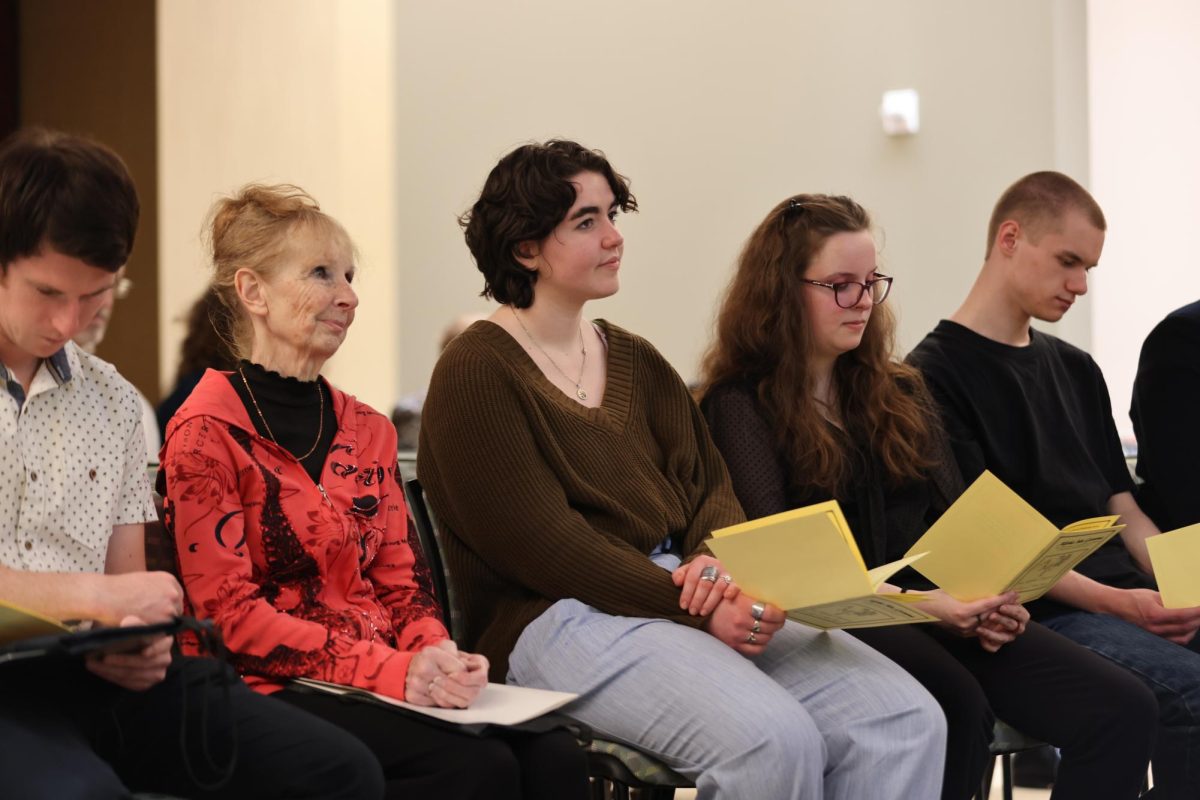The latest installment of College of DuPage’s Writers Read series revealed a fact rarely considered in the daily consumption of media. All the best films you’ve ever seen are built on a skeleton of audio and visual storytelling born from a cutthroat competition that occurred nearly a century ago.
Enter COD film professor Brian Brems and WDCB’s “Those Were the Days” radio host Steve Darnall. Together, the two hosted a presentation exploring the overlap of the Golden Ages of film and radio, and how material was adapted from one medium to the other.
The presentation highlighted another leg of the College of DuPage’s Writers Read Series. This year marks Writers Read’s 25th anniversary, and the series has brought dozens of critically acclaimed authors and writers to COD for a variety of events and panels.
Thursday’s event, hosted in the Berg Instructional Center’s new film screening room, began with an explanation of the state of film and radio prior to their respective golden ages, and specifically the role that the “classic Hollywood studio system,” as Brems puts it, played in film and radio adaptations.
The dawn of this system created a “highly integrated, stable business, with a lot of predictable revenue streams,” Brems explained. “The studio bosses held a high degree of control inside the studio system during this period.”
However, Brems said Hollywood has always felt uncomfortable when their entertainment dominance is challenged by another medium that enters the entertainment space. This scenario is not a new phenomenon; in the 1950s television began to challenge Hollywood’s dominance, and more recently, the streaming revolution of the 2010s dramatically changed the entertainment landscape. In the 1920s and ‘30s, however, cinema’s largest threat was the dawn of the home radio.
“Radio posed a threat to the film industry; among other things, it was free,” Darnall said. “Here was something that promised you entertainment, to where you did not have to pay admission. It [radio] marked the first time that entertainment came to us, instead of going to a theater. So, the movie industry was terrified.”
The duo explained that while Hollywood’s initial, fearful reaction to radio led to a complete avoidance of it, the division between the two mediums slowly began to dissipate over time. Famous actors often appeared on radio shows, occasionally reading Broadway scripts for viewers, and after a number of years, Hollywood studios finally understood radio’s popularity could be utilized as a means of promotion for movies.
“This really helped break down the barriers between radio and Hollywood,” Darnall told the audience, “For the next, roughly two decades, radio and Hollywood worked pretty much hand-in-glove.”
Darnall went on further to explain that one of the greatest aspects of radio and Hollywood’s collaboration was how it allowed movie stars to be brought into the homes of the American public. Now, listeners were reminded of what (Hollywood) studios were working on, while simultaneously experiencing the capabilities and benefits of radio.
At this point in their presentation, Brems and Darnall moved into showing examples of films that were adapted for the radio, and vice versa. For each piece of media, they presented a clip in its original medium, whether it be radio or cinema, followed by a clip from the adapted medium, and highlighted the similarities and differences between the two.
The most prominent difference shown was the cinema’s use of visuals to communicate with audiences and the radio’s solution to this unique problem. A radio program that adapts a film for its listeners must creatively utilize dialogue and explanations to communicate parts of a film that may rely strictly on images and visuals to move the story along. This point was best demonstrated through the film “Libel,” whose highly visual nature forced the radio adaptation to employ clever pieces of dialogue that allowed the listener to understand the story without too much alteration.
Another key difference in adaptation was exemplified through the hugely successful radio program, “Sorry, Wrong Number.” The program achieved so much popularity that Hollywood decided to create a film adaptation. However, Brems explained that the brief length of the radio program (30 minutes) forced the film adaptation’s directors to slightly deviate from the original story. The most noticeable deviation came through the use of suspense and surprise in the story: While the radio program used surprise to shock listeners at the conclusion, the film eliminated that feeling of surprise and replaced it with a feeling of suspense through the length of the film until its conclusion.
Overall, Brems and Darnall explained cinema and radio both attempted to go in the same direction. They (film and radio) wanted to decide what the best methods were to focus the audience’s attention on the details of the story that mattered most. Once they were able to perfect this craft of adaptation, both mediums thrived and built upon each other for about two decades between the late 1930s and early 1950s.
Apart from learning allowing us to gain a deeper understanding of the Golden Ages of film and radio, Brems reminded the audience of the benefits that come from a knowledge of film.
“Anybody studying film at this point in history really does themselves a favor,” Brems explained, “because they’re trying to understand more effectively how images interact with the people who see them, and that’s really crucial in a society that’s so image dominated.”
Brems concluded by focusing on the importance of the Golden Age of Hollywood specifically, as it provided the structure for everything we watch today.
“The Golden Age of Hollywood, the classic studio era, really establishes the paradigm for what we think of as movies. Everything that we watch today comes out of what’s left of the studio system. The practices of storytelling, the production methods, the way that storytelling is communicated, all of that gets established by the classic Hollywood studio system.”







